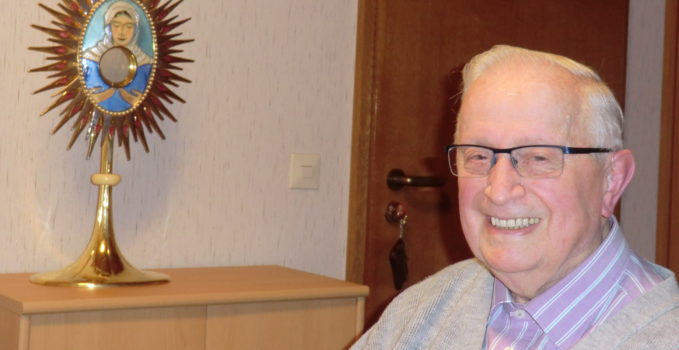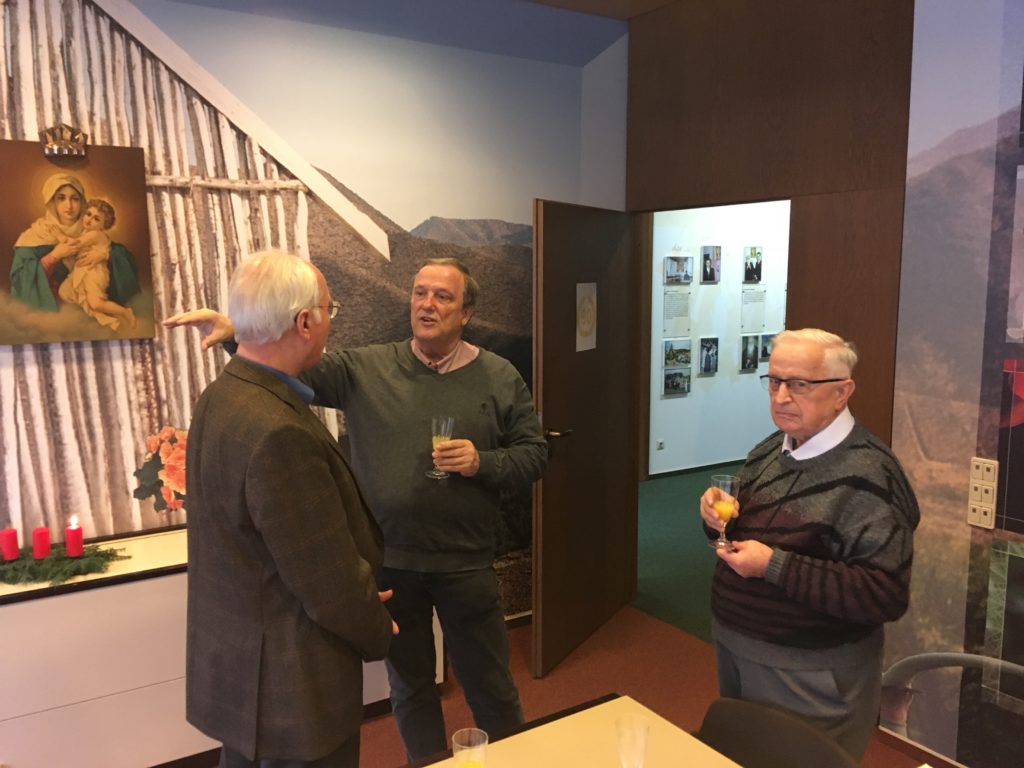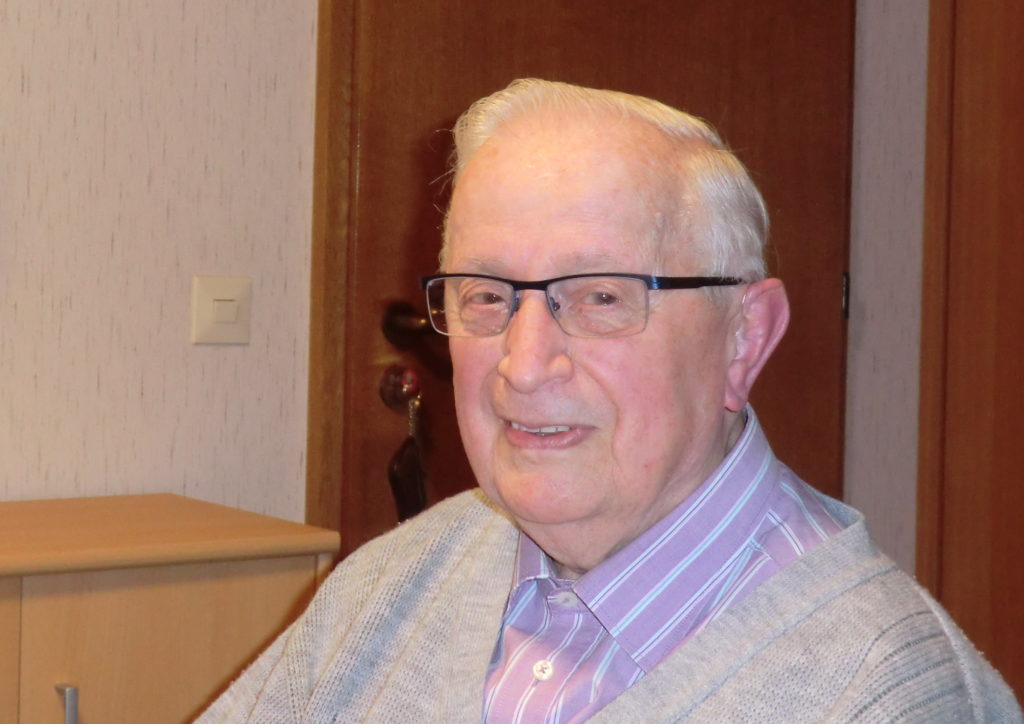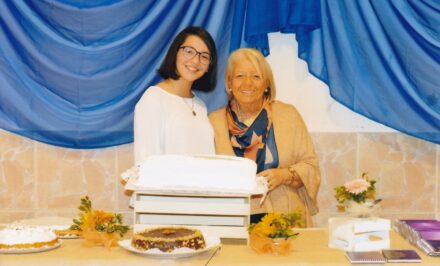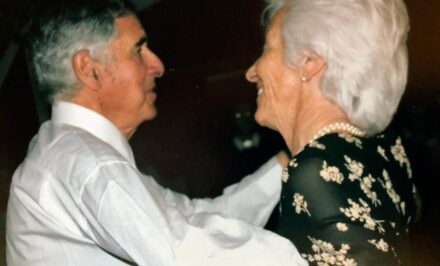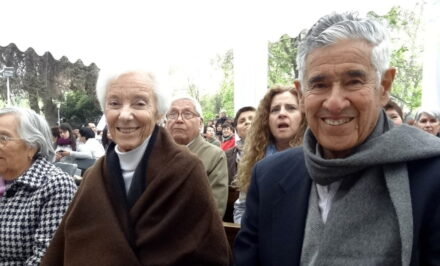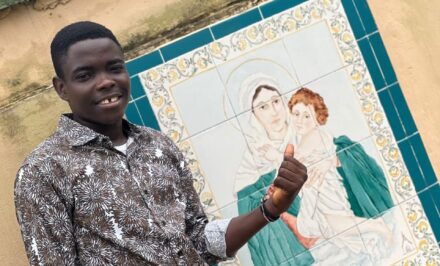On the 90th birthday of Paul M. Rothgerber, Brother of Mary •
Roberto Gonzales met me at the door of Mario Hiriart House, the Central House of the Secular Institute of the Schoenstatt Brothers of Mary. It was a dark evening in Advent, and we didn’t go in by the direct route, instead we went through the goldsmiths’ shop. There you find precious symbols in all sizes and materials that give expression to Schoenstatt’s world of values. Still today they proclaim the covenant of love and our covenant culture all over the world, for example, in little items such as medals, the Unity Cross or crowns, but also in large works of art such as monstrances, chalices, tabernacles and items for the altar. All of them bear his traces, the traces of a pioneer who started out in the “Old Goldsmith’s” with its many nooks and crannies, and continuing in the new Goldsmith’s: Paul M. Rothgerber. On 6 December 2017 he celebrated his 90th birthday.
He greeted us with radiant eyes and happy smile, alert and overjoyed to be interviewed. I could have saved myself the “introduction” I had prepared, I reflected, because this man was so keen to tell us his story and the history of his life. Nevertheless the introductory question I had prepared was presented: “You came from the Federation for Young Men, didn’t you, Mr Rothgerber, from the first course? Are you our Father’s pioneer?”
His vocation to Schoenstatt
Paul M. Rothgerber’s face lit up, then everything bubbled out: About the New Year conferences, his ideal “Our Father’s Pioneers”, and their symbol at that time – a spade, which he still has. It was his “first love”.
He was eighteen when he returned home from World War II and its terrible experiences, and Fr Alexander Menningen began to gather the scattered young men to build up the Schoenstatt Youth once more. He wanted them to deepen their vocation to Schoenstatt, which had held up through all their war experiences and had supported them through the most difficult trials.
“Fr Menningen led the candidature for the Young Men’s Federation”, Paul Rothgerber said. “It was a very special time, a step in a sound development from the youth. It was a very sound and organic development.” To start with Fr Menningen looked for leaders for the groups and trained them to build up the Youth Branch. With shining eyes the jubilarian continued, “You could feel that with one or the other a further step would be taken, and that they had taken a particularly firm decision to commit themselves completely to Schoenstatt. Then the Federation was mentioned as a very organic development of that vocation.” Perhaps my surprised reaction brought him to enlarge on this point. “It was a sound and organic development of a vocation from the ground up to a way of life that committed everything to and for Schoenstatt. Today it is so disjointed: You go here or there, and at one point you decide to join a section of the Movement, or you don’t decide. With us at that time it was organic based on our calling to Schoenstatt, and every step was a deepening of an initial decision, starting with the first consecration to the Blessed Mother.”
His consecration to the Blessed Mother, his covenant of love, took place secretly on 8 December 1944 hidden under his blanket in the barracks in Denmark. On that day his friends in the Waldstetten Schoenstatt group entered into their covenant of love, and those who could not be present joined in from wherever they were. “At that time it was simply a serious act. We sent in our consecration prayer and with it we sealed our decision. At the beginning everything was there that developed later and proved its worth in practice in everyday life in the realities of the war. The Young Men’s Federation, and the decision to join the Federation, was the deepening of a decision that was marked by the war, and hence included the maturity of the act.”
This interview with a ninety-year-old became a contribution to the Youth Synod about faith, vocation and discernment.
When was the Young Men’s Federation founded? What was your orientation?
The beginning was apostolic and took place in 1946. It involved pioneering work. We had to re-organise the entire work with the youth; all the leaders met and started the magazine again. “It began with the Candidature (“A wonderful time from which you can draw for the rest of your life.”). We started to make contact with the group around Fr Monnerjahn and Fr Mosbach in the Pallottine College. Fr Menningen led the young men deeper, “and in the background in Schoenstatt there was naturally Fr Kentenich.”
The values of the Federation fascinated these young men. “The Candidature led us to self-discovery as people, as Schoenstatters. It was an organic preparation for the next step – our vocation to a definite way of life in Schoenstatt. In this time the vocation to the Brothers of Mary was maturing in me, but what was decisive was this generation of the Federation. As a young person you first have to find yourself and receive; you have to shape your life from Schoenstatt’s spirituality.”
What was your personal discovery?
“I got to know Schoenstatt before my military service. Then came my wartime deployment, the consecration in 1944, and after the war the certainty: I wanted to live wholly for Schoenstatt.”
The eighteen-year-old had visited Schoenstatt already in 1945 and had taken part in his first retreat with Pallottine Father Distelkamp. Then in 1947 he began his Candidature in the Young Men’s Federation. “My main concern was my inner goal to commit myself completely to Schoenstatt, to take the next steps and not get stuck.”
How did your vocation to the Brothers of Mary come about?
“I then heard that there were Brothers of Mary”, Paul M. Rothgerber said. “Inwardly I simply wanted to follow my calling to Schoenstatt, initially in the Candidature of the Young Men’s Federation, and organically onward, step by step. I built up the Schoenstatt Youth, visited groups, talked with the young people and took in their needs. You are led, then you have the strength and you trustingly do things you would otherwise never have done. …” Then he met a young man who had decided to join the Brothers of Mary, and this young man impressed young Paul M. Rothgerber, who then embarked on this way of life. However, he spent a long time with the Young Men’s Federation together with the others who gradually decided to become priests, or join the Family Federation, the Brothers of Mary – each time to be “totally Schoenstatters”.
All this took place at a time when Schoenstatt was being examined by the Church. The founder had been sent into exile, and the existence of his work hung in the balance. “I wanted to commit myself completely to Schoenstatt.” Nothing was shaken even for a moment.
“Fr Kentenich was a very modest man”
Paul M. Rothgerber said that he had met Fr Kentenich in the time he was in the Young Men’s Federation, hence before 1951. “For us Fr Menningen was in the foreground. Fr Kentenich kept himself in the background. He sometimes asked us how we were, and he let us get on with life.” What did that mean in detail? “The formation in the Candidature was a matter for Fr Menningen, but from time to time we also sat round the table with Fr Kentenich. We asked him questions, and he took a more personal interest in us. Things were very different, Fr Kentenich was a very modest man.”
We take a jump in time to what happened after Fr Kentenich’s return from exile. “Fr Kentenich wanted to spend a week living with us Brothers of Mary. We took him in, and he wanted to have the smallest room in the house. Today I think that he had such great plans he wanted to discuss with us, but we were so full of our own little problems and questions, so he just came down to us into these tiny, unimportant things. He had such a great vision of the future, yet he entered into our narrow concerns. Narrowness, not just in thinking, but also at that time in our house. He said: You have to build. Everything here is so restricted and far too loud.”
Did he also take an interest in your work?
“And how! Already in 1965 in Rome and then in Schoenstatt he repeatedly asked about my work. Does it interest you? I asked.” Fr Kentenich really was interested. “He wanted to know the practical details of my work, how I got orders, how we dealt with customers, what the work entailed until something had taken shape, what sort of instruments I used. He really took an interest.”
“It is not my mission to support the vanity of women!”
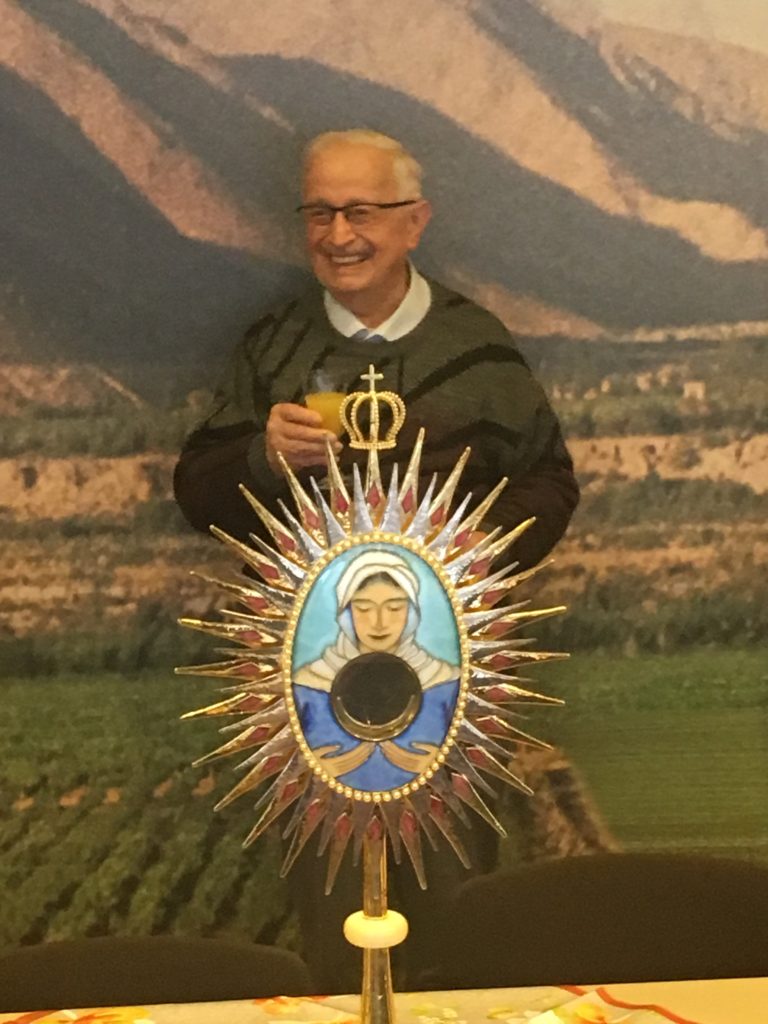 The key word “vocation” had been my objective all along. Whoever speaks about Paul M. Rothgerber speaks about crowns, Father symbols, monstrances, stations of the cross, etc. Whoever speaks of Paul M. Rothgerber, speaks about the Goldsmiths of the Schoenstatt Brothers of Mary. How did this come about, how did he hit upon a goldsmith’s of all things?
The key word “vocation” had been my objective all along. Whoever speaks about Paul M. Rothgerber speaks about crowns, Father symbols, monstrances, stations of the cross, etc. Whoever speaks of Paul M. Rothgerber, speaks about the Goldsmiths of the Schoenstatt Brothers of Mary. How did this come about, how did he hit upon a goldsmith’s of all things?
When he decided to join the community of the Brothers of Mary, Paul M. Rothgerber had already completed his training as a goldsmith. He related that Fr Menningen simply looked at the jobs of the first candidates and asked what they could make of them. “I had been making jewellery and told Fr Menningen straight out: ‘It is not my mission to support the vanity of women!’” Fr Menningen then showed him that there was more behind it, that he could give expression to Schoenstatt’s world of values in symbols. “However, he had to ask a number of times, because I really didn’t want to do it. In the end he almost pleaded: ‘Paul, will you do it?’ That was when Paul decided. Then directly after the Novitiate he continued his studies with the emphasis on sacred art and how to acquire the skills in dealing with very different instruments. For his Master’s examination in 1953 he made a monstrance that can be found today in the house chapel of Mario Hiriart House. It depicts Mary as the Christ-bearer. In the winter semester of 1952 he began to work at the Technical College on the enamel part of this monstrance. In Spring 1953 he continued working on this project and completed it in the Hockenmaier workshop. A very Christmassy subject.
With great modesty Mr Rothgerber told me how he had slowly worked his way into expressing Schoenstatt’s spiritual world. The first crown, he admitted, was still very theoretical, marked by his parallel studies in theology. “I wanted to show what I had learnt”, he said. Gradually he grew into expressing the specific qualities of our Schoenstatt world.
What would Schoenstatt be without him, without this man who had placed his vocation as goldsmith at the service of Schoenstatt?
“You will send us the vocations”, I quoted to him from “Heavenwards”, and explained that I took those words literally, not merely with regard to someone’s calling, but to their work. At about the same moment we both thought of something a Brother of Mary, the late Hermann Arendes, had said many years ago during a conference for working women. “If all of us wanted to become Schoenstatt priests, parish workers or nurses, we could immediately forget about our mission to shape the world. We need people who shape the world – blacksmiths, forest rangers, engineers, journalists, chemists, mechanics …”
Selfless service to another’s life
I already knew the answer, because it was the answer to the question about “Schoenstatt journalism”, but I had to ask it, “What constitutes a Schoenstatt goldsmith?”
“Our conversation with our clients, listening to what they want, what moves them. Our clients can and must find themselves, not the goldsmith, in the finished product. They bring along a small item that is precious to them and want it worked into the finished article. We have to listen attentively and with interest, in a way that opens and inspires them. …” Roberto and looked at each other. “Selfless service to another’s life.”
We would really have needed days to look at the many and varied crowns Mr Rothgerber had created. Behind each crown there is a person, a story, a community, many stories. It is the same with the Father symbols, the symbols of the Blessed Trinity, the chalices … Each symbol gives expression to the creative force of the covenant of love; each symbol reveals a spiritual current that has been captured in a form; it is life captured in a form. “If you can say this, your work is truly a vocation”, Paul Rothgerber confirmed. “That is what interested Fr Kentenich about my work: how I got involved with the client, what happened so that in the end the symbol corresponded to what the client had wanted and he or she could say: That’s us.”
“It has something to do with respect, reverence”, he said. “The client discloses something of themselves, and you can’t take that superficially. Of course, if you personally live in this world of values, it is easier. If you have been part of the spiritual currents alive in Schoenstatt from the beginning, it makes a great difference.”
Ever so often he had taken designs and ideas into the shrine, and “connected the work with heaven”.
“Indeed”, he affirmed, “things have moved and changed as the years and decades unfolded.” Then it reappeared, that wonderful smile. “You are always a pioneer.” A wonderful conclusion.
Then, as the only woman in a group of men, I was still turning over his remark about jewellery and women. Mr Rothgerber laughed. “Fr Kentenich also had something to say about it. He said that it is important for women to adorn themselves, it has a value which we may support.”
Original: German. Translation: Mary Cole, Manchester, UK


